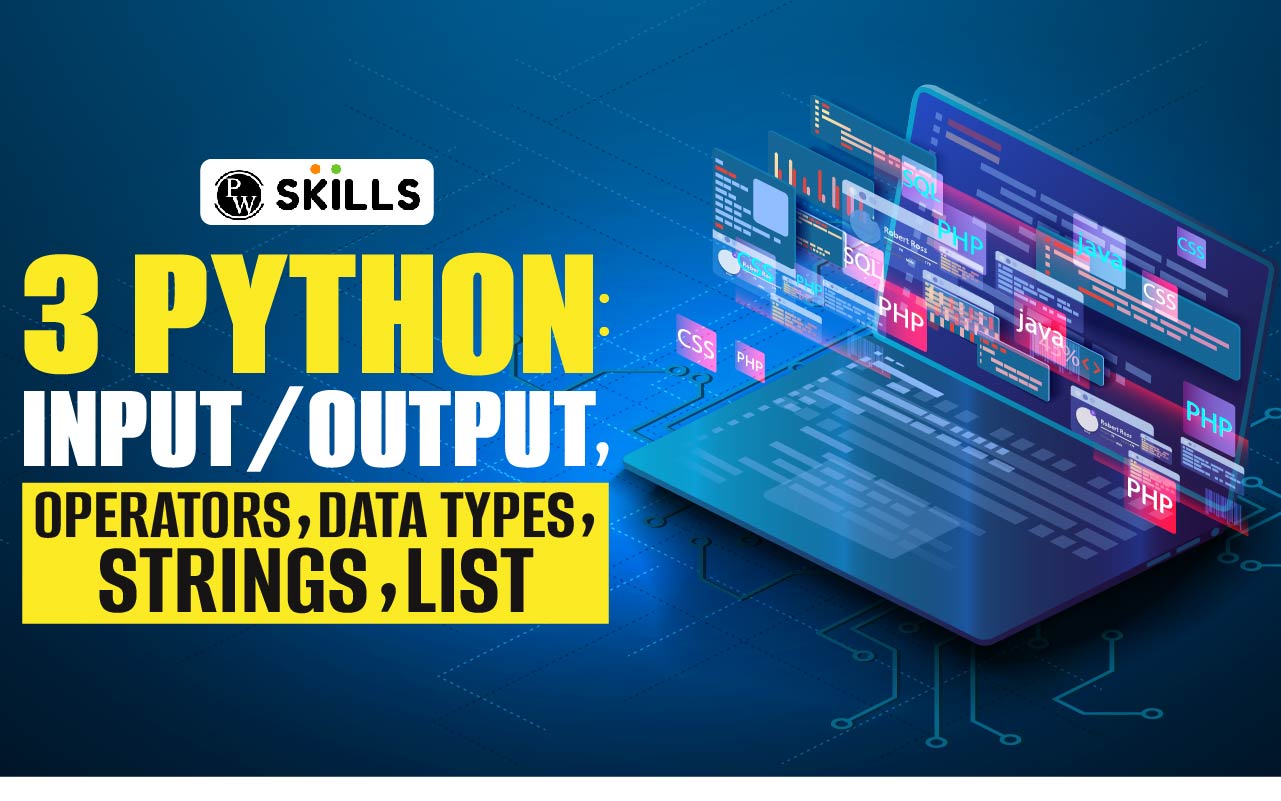Every student interested in the world of computer programming knows by now that Python is a high-level, object-oriented programming language that comes with dynamic typing, and built-in data structures. It offers a straightforward, basic syntax that prioritizes readability, and the language was first developed as a script authoring tool. Several of the scripts and tools included in Linux operating systems are written in the Python programming language.

Since the introduction of 3 Python, the language has expedited the program development process by offering a wide range of libraries to simplify coding. The written code may also be tested and executed by developers in Python without requiring a separate compilation step. One reason for its simplicity is its simple syntax, which defines code blocks using line breaks rather than symbols.
However, many students wonder about the additional uses Python has, and if they can gain employment benefits after learning Python since it has become such a well-liked commercial programming language. We can assure you that you will have an edge in the competitive job market if you gain expertise in Python. Take a look at this course structure and you will see the skills you can gain by taking the course. Python’s adaptability with frameworks and packages that increase its usefulness is what makes it so popular in the job market. Let’s take a look at the basics of Python and the way its elements, including Input/Output, Operators, Data Types, Strings, and List, work.
Recommended Technical Course
- Full Stack Development Course
- Generative AI Course
- DSA C++ Course
- Data Analytics Course
- Python DSA Course
- DSA Java Course
The Basics of 3 Python
Python has come a long way since its inception in the 1990s, and in that time, several iterations have been made available for the users. 3 Python was developed to address some of the drawbacks of Python 2 and is presently in use. Simply spoken, the development of Python has revolutionized the field of computer science and as a result, it has gained popularity among coding experts due to its ease of use and simplicity. Python is now regarded as a popular programming language even for the novices in the field of coding.

It is being utilized for a wide range of coding tasks and in practically every industry due to its strength and exceptional versatility as a programming language. However, Python 2 had a few serious design flaws that needed to be fixed before 3 Python could be released. Python 2 could still function, but the necessary improvements could not be implemented and that is the reason 3 Python was created.
Input/Output
Now, let us delve into the world of Python with a bit more details and talk about Python Input/Output functions. Any Python input from the user should be successfully communicated by a decent program, and the output should be correctly produced. A user can utilize data from an external source, such as a file or database, or manually enter data into the software using a keyboard. Python provides us with a number of built-in functions that facilitate the rapid creation of programs. The input() and print() built-in methods, which are frequently used for input and output operations, respectively, are two of the most frequently used built-in functions.
1) Python Input
Python programmers frequently require user input in order to launch an application and using the input() method is the easiest way to accomplish this. The function allows the user to enter a line of text using the keyboard by pausing program execution. The user’s input is received and returned as a string when they press “Enter.” To utilize the input() function, programmers adhere to the syntax input([<prompt>]).

The input() method only takes string parameters by default nut users can use the float() and int() methods to convert this to a number.

Another similar method as int() and float() is eval(), and if the input is a string, eval() may also analyse expressions.

2) Python Output
After receiving input in Python and processing it, the program returns the processed data to the user as output. The data output can be shown on a screen via a graphical user interface (GUI) or straight to the console (or IDE), and it is even possible to return it to an outside source. The output data is shown on the console (screen) using the print() function.
![]()
By using the aforementioned syntax, the programmer may give several instructions (<obj>) to be used by the print() method, with commas used to separate them.

The output of these instructions will be:
![]()
Python Operators & How They Work
Operators in Python are unique symbols, keywords, and symbol combinations that represent different calculation types. Combining operators and objects allows you to create expressions that carry out the calculation, and that is why operators are the fundamental units of expressions that you may use to work with data. It is therefore imperative that you as a coder comprehend how Python Operators work.
A collection of effective functions that map to Python’s intrinsic operators are exported by the operator module. Special methods often have function names instead of double underscores and many of them have a variation that retains the double underscores for backward compatibility. For clarity, the versions without the double underscores are recommended for new users. The functions are divided into groups that carry out mathematical operations, sequence operations, logical operations, and object comparisons in the language.
There are multiple operators in Python and we have discussed them below. You can learn all about these operators in the Python course offered by PW Skills.
1) Arithmetic Operators
The operators that let you do arithmetic operations on numerical quantities are known as arithmetic operators and you will typically express them using standard math symbols.
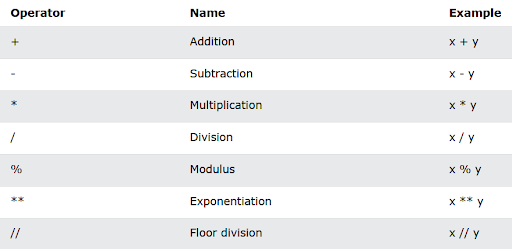
2) Comparison (Relational) Operators
You may compare numerical values and any other items that support them with the comparison operators in Python. Each comparison operator has a binary value, which indicates that both left and right operands are needed. Regardless of the comparison’s truth value, these operators always return a Boolean result (True or False). Keep in mind that comparisons between Python objects of various data types frequently result in illogical answers and are occasionally prohibited.
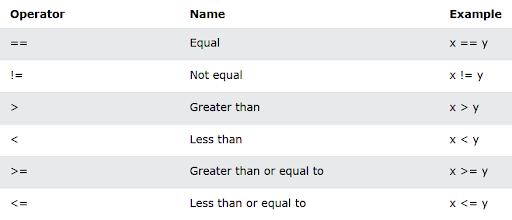
3) Assignment Operators
Assignment operator is one of the most used operators in Python and this operator acts on two operands, and is composed of a single equal symbol (=). Usually, an expression is the right-hand operand and a variable is the left-hand operand, and you may assign values to variables using the assignment operator. In technical terms, this operator in Python creates references for variables or names that point to certain memory locations on your machine. Stated differently, an assignment operator establishes a connection to a tangible entity and affixes that connection to the intended variable.
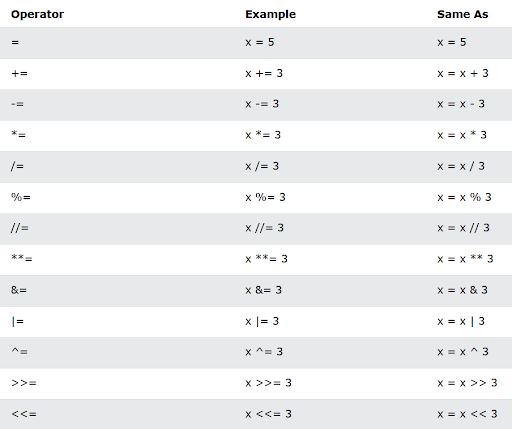
4) Logical Operators
Three Boolean or logical operators exist in Python, AND, OR, and NOT, and using these generic operators, a programmer describes a set of operations. Compound circumstances can be created with these operators but the majority of Python expressions and objects aren’t logical operators. Put another way, the majority of objects and expressions have a different kind of value rather than a True or False value. But in a Boolean context, like a ‘while’ loop or a conditional statement, you may utilize any Python object. Every object in Python has a unique truth value and logical operators can be used to any kind of operand.

5) Bitwise Operators
Bitwise operators act on operands bit by bit, treating them as sequences of binary digits, and most bitwise operators demand two operands since they are binary in nature. The bitwise NOT operator (~) is the sole unary operator because it only demands a single operand, which must always be at the right side of the statement. The bitwise operators in Python allow you to work with data at the smallest possible scale, which are individual bits. These operations come in handy for writing low-level algorithms, including those for encryption and compression.
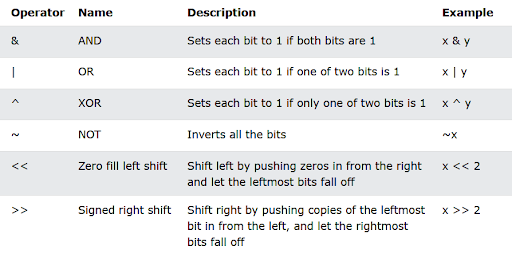
6) Membership Operators
There are situations when you need to find out if a value exists in a container data type, such as a list, tuple, or set. You might need to determine if a certain value belongs to a collection of values or not and this type of check is known as a membership test in Python. In programming, membership tests are extremely popular and helpful and Python includes specific operators for membership checks, just like it does for a lot of other common operations.

7) Identity Operators
To find out if two operands have the same identity, Python has two operators, ‘is’ and ‘is not’. They enable you to determine whether the operands allude to the same thing, but you should keep in mind that equality and identity are not the same thing. The latter only seeks to determine if two operands have identical data and nothing more.

3 Python Data Types
The categorization or classification of data elements is known as Python Data Types and it stands for the kind of value that indicates the operations that may be carried out on a certain set of data.
1) Numeric Data Types
In Python, data with a numeric value is represented by the numeric data type and an integer, a float, or complex numbers can be a part of a numeric value. The Python float, Python int, and Python complex classes describe these values.
2) Sequence Type
Python defines a data type as an ordered collection of either distinct or comparable data types and the sequence type provides the efficient and well-organized storage of numerous variables. Python has several types of sequences which are String Data Type, List Data Type, and Tuple Data Type.
3) Boolean Data Type
True or False are the two pre-installed values for this data type and it is possible to evaluate non-Boolean items in a Boolean environment and decide if they are true or false.
4) Set Data Type
A changeable, and iterable collection of data types with no duplicate components is called a set data type in Python. Even though a set may contain a variety of components, the order in which they appear is not specified in the programming.
5) Dictionary Data Type
As opposed to other data types that only contain a single value as an element, dictionary data types in Python retain a key:value pair and are used to store data values in an unordered collection similar to a map. To improve optimization, the dictionary data types provide key-value and in a dictionary, a colon (:) separates each key-value pair, whereas a comma separates each key.
3 Python Strings
The Python String is made up of unchangeable Unicode characters and the UNICODE standard assigns a distinct numerical value to each character. Despite the fact that every letter in the sequence is a digit, the sequence as a whole has no numerical value. The literal form of the character sequence is enclosed in single, double, or triple quotations to distinguish it from numerals and other identifiers. It doesn’t matter if the quotes are single, double, or triple as long as the same string of characters is contained and the string representations that follow are therefore equal.
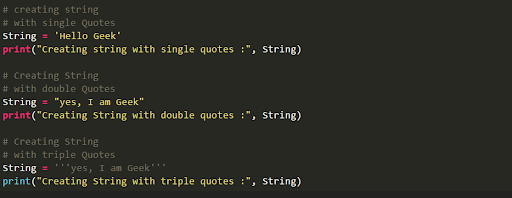
Updating or removing characters from a string is prohibited in Python because item assignment or deletion from a String is not supported, and this will result in an error. However, you can reassign a new string to an already-existing string in Python. Python RegEx, or regular expression, is a string of characters used to create search patterns, and if a string contains the required search pattern, it may be verified using RegEx.
3 Python List
Python List is an arranged grouping of elements that make a piece of data easy to utilize in the program. Square brackets ([ ]) are used to surround list values, which are then separated by commas, and placing a space between the comma and the next value is best practice. A list’s values don’t have to be distinct and the same value might appear more than once. One thing you should remember is that there are no values in square brackets on empty lists. The + sign can be used to add lists to one another, which will produce a new list of the same things in the same order, with the items from the first list appearing first.

The Output:
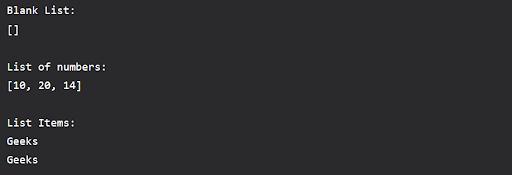
Why Opt for Python for DSA Course at Physics Wallah?
3 Python is the latest version of the Python language and is a great place for inexperienced programmers to start. Since Python 2’s support was discontinued, the language is quickly losing traction, and an increasing number of businesses are switching to Python 3 quickly. Learning 3 Python makes sense because of its increasing demand across a wide range of software fields and the job opportunities that come with it.
If you wish to hone your skills in 3 Python and get ready to enter the programming sector, we recommend studying the Python for DSA course offered by the amazing PW Skills Lab. You will not only learn the 3 Python language but also learn about Python code for DSA. The certificate you receive after completing the course can be your magic card to get hired by prestigious software companies.
For Latest Tech Related Information, Join Our Official Free Telegram Group : PW Skills Telegram Group
3 Python FAQs
Is it necessary to learn Python 2 to become an expert in Python 3?
The most recent version of the Python programming language is Python 3, which you may learn without prior knowledge of Python 2. If you're new to studying Python, it makes sense to start with Python 3 because Python 2 is already outdated. Most large companies have already switched to Python 3, which is why many online courses concentrate on the most recent Python 3 version. However, if you already know Python 2, you will undoubtedly find it easier to master Python 3 since the two versions share a lot in common. The difference is that Python 3 has new benefits and upgraded tech that Python 2 didn’t have.
What are the beneficial features of Python 3?
This object-oriented programming language is popular now because of a few highly beneficial characteristics. The language is interpreted, dynamically composed, object-oriented, and free and open-sourced. It is simple to write code in Python 3 with its large library support, and it is also GUI-supported.
Is learning Python 3 easier than learning Java?
Python is an interpreted language with dynamic typing, whereas Java is statically typed and compiled. That is why Python is simpler to use and read, but Java is quicker at runtime and easier to debug. Python's communicative nature has contributed significantly to its growing popularity because people understand it better. A novice coder won't have to start from scratch because of Python's vast library of functions. Java is considered one of the gold standards in the programming world, but the learning curve of Java can be much harder.
Why is Python used more than other programming languages?
Python is a high-level programming language with an emphasis on the readability of code, and its syntaxes are simple and use basic English vocabulary. The object-oriented, procedural, and functional programming paradigms are supported by Python, and code extensibility, modularity, and reusability are made easier by the object-oriented programming methodology. Python works on several different operating systems because the language is portable and cross-platform. Programmers can write code once and run it on many systems without having to make any modifications, which saves time and effort.
Does Python have design restrictions?
Yes, Python has design restrictions, which is one of the limitations of this programming language. Python has dynamic typing, which is the cause of this kind of restriction, and the data types of variables do not need to be defined by developers. Based on the value appended to a variable, the Python interpreter automatically determines the variable's data type, and runtime errors are the outcome of this.

